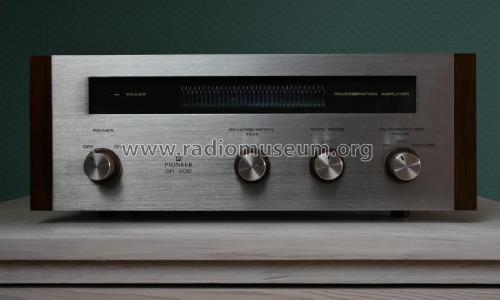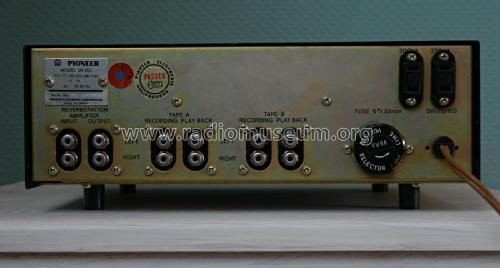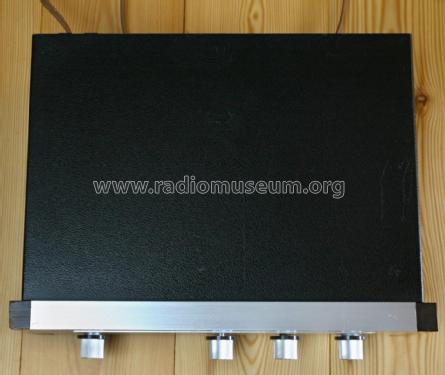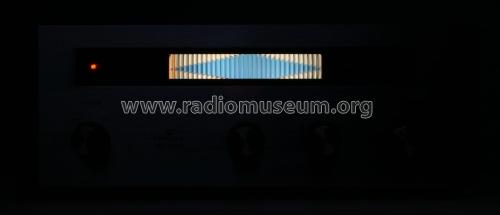Reverberation Amplifier SR-202
Pioneer Corporation; Tokyo
- Land
- Japan
- Hersteller / Marke
- Pioneer Corporation; Tokyo
- Jahr
- 1969/1970
- Kategorie
- NF-(Niederfrequenz-) Verstärker oder -Mixer
- Radiomuseum.org ID
- 359930
- Anzahl Transistoren
- 11
- Halbleiter
- Hauptprinzip
- NF-Verstärkung
- Wellenbereiche
- - ohne
- Betriebsart / Volt
- Wechselstromspeisung / 50/60Hz 110; 117; 130; 220; 240 Volt
- Lautsprecher
- - Für Kopfhörer oder NF-Verstärker
- Material
- Metallausführung
- von Radiomuseum.org
- Modell: Reverberation Amplifier SR-202 - Pioneer Corporation; Tokyo
- Form
- Regalgerät wie HiFi-Komponente für Bücherwand.
- Abmessungen (BHT)
- 330 x 118 x 319 mm / 13 x 4.6 x 12.6 inch
- Bemerkung
-
The Pioneer SR-202 is a solid-state reverberation amplifier introduced in 19690. This unique device was designed to enhance the naturalness of audio playback by adding reverb effects to various sources such as recorded voices, radio broadcasts, records, and tapes.
Key Features
- Double Scatter System: Unlike single scatter systems, the SR-202 employs a double scatter system that merges and blends two channels to create a complex composite sound.
- Time Delay Circuits: Two time delay circuits eliminate peaks and dips in reverberation, resulting in stable sound with depth and brilliance.
- Flexible Integration: The SR-202 can be coupled with existing amplifiers (with tape monitor jacks) in various configurations, allowing users to apply reverb effects to speakers, recorded sounds, or both.
- Multiple Connection Options: It supports various connection setups, including the ability to control two tape recorders simultaneously for recording with or without reverb.
Technical Specifications
- Input Level: 200mV (3V maximum)
- Output Voltage: 330mV
- Harmonic Distortion: 0.2%
- Frequency Response: 20Hz to 35kHz
- Signal to Noise Ratio: 65dB
- Reverberation Time: 1.9 to 3.2 seconds
- Semiconductors: 11 transistors, 2 diodes
Anzahl der Eingänge: 3 Line: 200mV, Hallzeitminimum 300kOhm, max. 3 V (bei 1kHz, Nachhallpegelregler:0)Tape Play 1: 200mV, Hallzeitminimum 300kOhm, max. 3 V (bei 1kHz, Nachhallpegelregler:0) Tape Play 2: 200mV, Hallzeitminimum 300kOhm, max. 3 V (bei 1kHz, Nachhallpegelregler:0) Ausgänge: 3 Line: 330mV Tape Rec 1: 330mV, 10 kOhm (1 kHz) Tape Rec 2: 330mV, 10 kOhm (1 kHz) Technische Daten Reverbzeit: 1,9 - 3,2 sek (1 kHz) Frequenzgang: Hallzeit Min.: 20Hz bis 35kHz ± 2dB Hallzeit Max.: 20Hz bis 50kHz ± 10dB Gesamtklirrfaktor: < 0,2% (Hallzeit Min.und Max. bei 330 mV) Rauschabstand: > 65dB bei 330 mV Ausgangsspannung Weitere Ausstattung: 5 Positionen Schalter für Nachhall allein und Lautsprecher, oder Nachhall allein/und Tonband- oder Kassettengeräte
- Nettogewicht
- 4 kg / 8 lb 13 oz (8.811 lb)
- Literaturnachweis
- - - Manufacturers Literature (Pioneer prospect 1969/70)
- Autor
- Modellseite von Peter Liska angelegt. Siehe bei "Änderungsvorschlag" für weitere Mitarbeit.
- Weitere Modelle
-
Hier finden Sie 1151 Modelle, davon 1135 mit Bildern und 201 mit Schaltbildern.
Alle gelisteten Radios usw. von Pioneer Corporation; Tokyo
Sammlungen
Das Modell Reverberation Amplifier befindet sich in den Sammlungen folgender Mitglieder.








